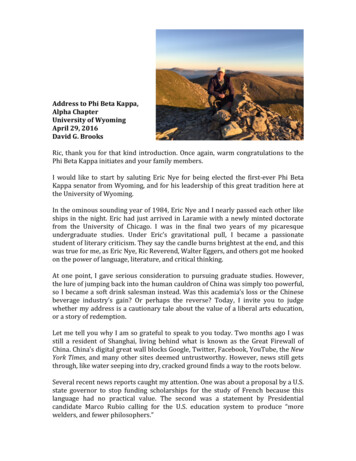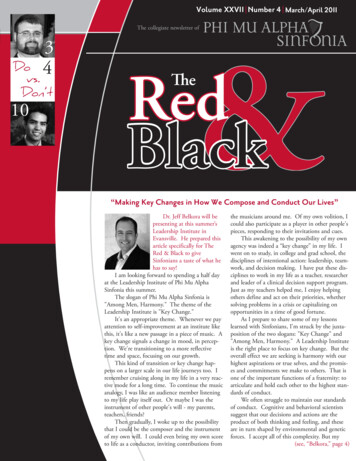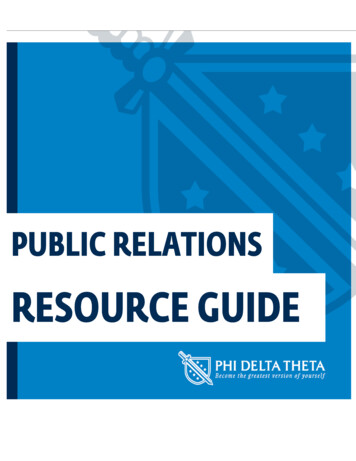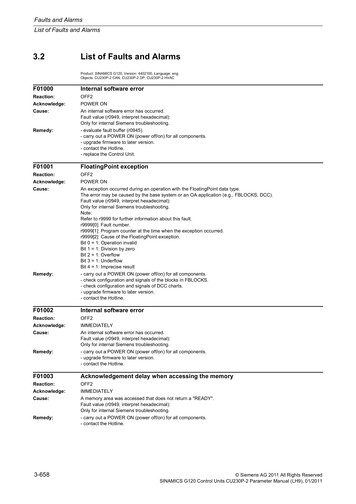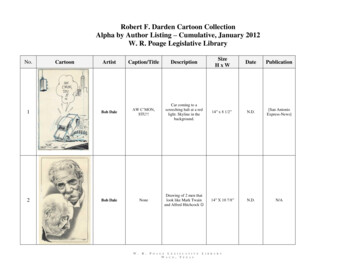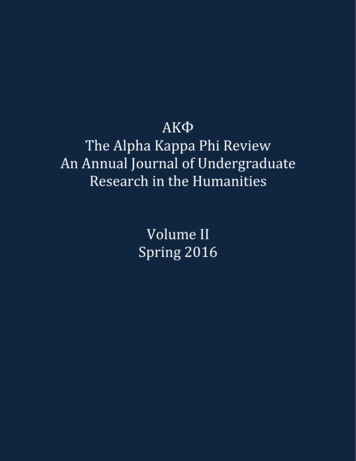
Transcription
ΑΚΦThe Alpha Kappa Phi ReviewAn Annual Journal of UndergraduateResearch in the HumanitiesVolume IISpring 2016
ΑΚΦThe Alpha Kappa Phi ReviewAn Annual Journal of Undergraduate Researchin the HumanitiesVolume IISpring 2016AKΦ Review EditorTip H. Shanklin, PhDProfessor of EnglishAKΦ Review FounderPaul Thifault, PhDSpringfield CollegeΣΤΔSigma Tau Delta, Alpha Kappa Phi ChapterLindsey Wilson CollegeTip H. Shanklin, PhD, Faculty SponsorEmily Gunberg, PresidentElliott Porter, Vice PresidentPreslee Thrasher, Treasurer Copyright 2016All Rights Reserved
No thief, however skillful, can rob one of knowledge, and that iswhy knowledge is the best and safest treasure to acquire. L. Frank BaumThe advancement and diffusion of knowledge is the onlyguardian of true liberty. James MadisonA word after a word after a word is power. Margaret AtwoodThe most violent element in society is ignorance. Emma Goldman
CONTENTSPrefaceCody BakerExtremely Disturbed and Incredibly Tragic: Narrative Style in Foer’sExtremely Loud and Incredibly Close6Emily GunbergThe Position, Influence, and Infamy of Both Mortal and Divine Women inHomer’s Iliad9Carrie MasonIdentity Issues in Patricia Highsmith’s The Talented Mr. Ripley andGertrude Stein’s “Melanctha”14Jordyn PerryElectra-fied Greek Women in Aeschylus’s The Choephori24Elliott PorterEbony Phonics: The Origins, Controversies, and Persistence of Ebonicsin American Public Schools30Rebekah SandersBreakin’ Common Ground: Dialectal Identity and Code SwitchingAmong Stigmatized Dialect Speakers in the Academy37Notes on the Contributors
PrefaceVolume II of The Alpha Kappa Phi Review features the work of six LindseyWilson College students that range from a stylistic analysis of Jonathan Foer’s fictionalaccount of the disaster of 9/11, Extremely Loud and Incredibly Close; a feminist readingof both mortal and divine women in Homer’s Iliad, which also was presented at the FifthAnnual Women’s Studies Conference in April 2016; a comparison of problematiccharacter identity in Patricia Highsmith’s The Talented Mr. Ripley and Gertrude Stein’sstory, “Melanctha” (from her collection Three Lives); an analysis of Electra and her“complex” in Aeschylus’s The Choephori (The Libation Bearers), the middle drama inhis trilogy The Oresteia; an examination of the origins and oft controversial role ofEbonics in American public schools; and rounded out with a treatise on the equallycontentious subject of alternative “Englishes” and the practice of linguistic codeswitching among stigmatized students in academia. It is difficult not to be impressed withthe scholarly efforts of these students in the LWC English program and we are honored topublish their work.***Although he has moved on in his academic career, we are especially grateful toDr. Paul Thifault for founding and establishing the AKΦ Review in 2015, the soleundergraduate research journal at LWC.***Research-supported essays in the field of English and in the broader Humanitiessuch as Women’s Studies and History are welcomed and encouraged from any current orrecently graduated Lindsey Wilson College student. Essays should be formatted inappropriate MLA style and generally should not exceed ten pages including the WorkCited page. For more information, contact Dr. Tip H. Shanklin, Professor of English andEnglish Program Coordinator: shanklin@lindsey.edu.THSApril 2016
CODY BAKERExtremely Disturbed and Incredibly Tragic: Narrative Style in Foer’sExtremely Loud and Incredibly CloseWhat about skyscrapers for dead people that were built down? They could beunderneath the skyscrapers for living people that were built up. You could burypeople one hundred floors down, and a whole dead world could be underneath the livingone. Sometimes I think it would be weird if there were a skyscraper that moved up anddown while its elevator stayed in place that could be extremely useful, because ifyou’re on the ninety-fifth floor, and a plane hits below you, the building could take you tothe ground, and everyone could be safe, even if you left your birdseed shirt at home. Oskar Schell, from Extremely Loud and Incredibly Close (3)Those are powerful words that come from the first person narrator, Oskar Schell,in the novel Extremely Loud and Incredibly Close by Jonathan Safran Foer. Oskar’sfather died in one of the Twin Towers on September 11, 2001. Oskar lived in sorrow,regret, denial, and most of all, separation from his mother after his father tragically diedwhen the tower collapsed. Oskar wanted closure with his father dying, but he did not getthat because there was not a body in his dad’s casket when it was put underground.Oskar felt like a victim of a tragic crime because his father was taken away from him andhe did not understand why. Foer gives clues throughout the novel that reinforce the ideaof being separated before the attacks and being united afterward. At times, Foer writeslike Maurice Blanchot, a style of writing that seems fragmented. Foer does this todisplay the effect of the disaster, and how it is sudden and unfinished. With 9/11,Americans feel that the attacks on America must be relived, or reminded as if they willforget the tragic events even happened. In the novel, Oskar has photographs of the sceneof the falling man from the Twin Towers. Oskar flips through the photographs manytimes both in the novel and the film. He flips through them in two ways; one way showsthe man is falling out of the building, and one shows the man is going back into thebuilding, as if he can rewind time.After the attacks of September 11, 2001, Americans at the time were victims of anunspeakable crime, a crime that was so brutal that no one could fathom the idea behind it.Families were torn apart because of these shocking events that ended over two thousandlives. In both the novel and the film, Oskar, who is nine years old, and his mother weredeeply affected by the attacks. Foer is displaying to his readers the effect it would haveon a given family. Society would feel sorry for the child, and be very sympathetic. Onecould say that society felt badly for the child because he would be without a father, eventhough his mother was watching over him the whole time during his adventures.When Oskar started his adventures, he had a card that he gave to everyone heencountered. The card stated his name, his cellphone and home phone listed as private.The card also said, “Inventor, jewelry designer, jewelry fabricator, amateur entomologist,Francophile, vegan, origamist, pacifist, percussionist, amateur astronomer, computerconsultant, amateur archeologist, collector of: rare coins, butterflies that died naturaldeaths, miniature cacti, Beatles memorabilia, semiprecious stones, and other things.”7
Given that this is relatively in the beginning of the novel and relating it to the 9/11disaster, Foer is exhibiting a figure that before the attacks or before Americans wereinterrupted, they were all many things. Americans were of all different occupations.Later towards the end of the novel, Oskar gets a different card. The card simply says,“Oskar Schell: Son.” Foer here is uniting Americans, whereas at the beginningAmericans were separated by occupations. Not only are Americans united as one, butalso they are something stronger. Being a son would mean a family. Foer isdemonstrating that after the 9/11 attacks and Americans set differences aside, they wereunited as one family.The opposite of being unified is being alienated, detached, split, or broken. Foer’swriting style in many parts of the novel shows a detachment from the norm. At one partof the novel, the words gradually get closer together and three and a half pages cannot beread because the pages are almost completely black because the words are on top of eachother. Some pages only have one sentence located in the center of the page. Some pagesare nothing but one sentence per line, and some pages are just numbers. Foer uses thisstyle of writing to support the idea of the pain in the mind of the child, a pain that isindescribable because it is a pain that over two thousand particular families encountered.This fragmented style of writing is similar to the style of writing that Maurice Blanchotuses in The Writing of the Disaster. The writing style that Blanchot uses is very quick.He does not stay on the same topic for very long. He also uses bullet points instead oftypical prose style. Blanchot uses the bullet style because he is demonstrating thequickness and unresolvedness of a disaster. Americans will always feel unresolved with9/11. Americans believe they must hang signs that say “9/11: Never Forget,” as if it werea possibility to forget such acts.The attacks of 9/11 will always be remembered; Americans will never forgetthem. The novel ends with fifteen pages of the infamous “falling man.” If the pages areflipped fast enough from the beginning, it looks like the man is defying gravity andmoving upwards out of the picture. This action is a reminder to Americans that the pastis the past and will always be there. Also, it shows Americans how they constantly relivethe morning of September 11. This reliving and repetition goes hand in hand with whatBlanchot said about the disaster, any disaster: “We [those who experience the disaster]constantly need to say (think): that was quite something (something quite important) thathappened to me.” He goes on to explain that it is a constant repetition in regards to thosewho encounter a disaster.September 11, 2001 was a tragic day in American history. Many havememorialized the day with slogans and bumper stickers. Americans have created films,novels, and songs to display the memorialization, also. When brought in popular culture,the 9/11 attacks are often portrayed as American as the victim, and the after effects beingAmerica as the victor. Oskar from Extremely Loud and Incredibly Close was a victim ofthese attacks. Foer brings in many aspects to support the victimization of Oskar andAmerica as a whole. These popular culture texts show that America was vulnerable atone time, but it will not be vulnerable again. American culture can be described asvengeful as Americans sought vengeance for the slaughter of thousands of innocent liveson that September morning. If the American government gets vengeance against thosewho terrorized the country, are those who were affected by the attacks able to achieve8
closure because justice was served? Or should the victims of the disaster seek vengeancefor what they think is plausible justice?Works CitedBlanchot, Maurice. The Writing of the Disaster. Lincoln: U Nebraska P, 1995. Print.Foer, Jonathan Safran. Extremely Loud and Incredibly Close. New York: Mariner Books,2006. Print.
EMILY GUNBERGThe Position, Influence, and Infamy of Both Mortal and Divine Womenin Homer’s IliadHomer’s Iliad has been renowned throughout the centuries for its powerful battlescenes, cyclical plot lines, and the unforgettable glory of its warriors. The boundaries ofhumanity are stretched, and it has become an enduring demonstration both of war’sbloody futility and its eternal glory. However, because of the militaristic setting of thistimeless epic, women in the story occupy very limited positive roles, and often are seenas either a hindrance or the inspiration of violence. This pattern of prejudice againstwomen and female qualities has not only influenced literature, but has also affected theway both ancient and modern cultures view femininity.When reading the Iliad, it becomes clear that human women typically play one oftwo roles; there are some who are just seen as property, such as Chryseis and Briseis, andthose who are essentially just shadowy supplements to their male counterparts, such asAndromache is to Hector. Both of these categories however seem to exist only to providesome literary device, such as moving the plot along by sparking the feud betweenAchilles and Agamemnon. One of the most powerful moments in the epic is when theTrojan warrior Hector returns home to his devoted wife Andromache, only to discoverher distraught over the idea of his imminent return to battle, already mourning hiscorrectly anticipated death. Instead of creating a holistic example of a realistic woman,she is present only to provide a sense of empathy for her husband Hector. Andromacherepresents the families destroyed by the war, and what the men in the story have to lose.While this is an important sentiment, it does not make her a real person. As expected for
10a good wife during this period, Andromache exists only in relation to her husband andchildren.Helen, on the other hand, has been considered a problematic character forthousands of years because in some ways she falls into both classifications, and in otherways she does not fit this mold at all. Her role in the beginnings of the war is tragicallyunclear; it is a matter of opinion and interpretation whether or not she gave herself toParis voluntarily. Over the years, she has become the internationally recognized symbolfor lust, greed, and the evils that accompany femininity and beauty. However, for others,she has become an emblem for victims of sexual assault as well as a heartbreakingexample of the horrific results of what today is termed victim-blaming. Though thistireless debate will continue, it is apparent that she is neither a hollow prop, nor simply afigure meant to illuminate a male character. Unlike any other female character present inthe story, she is given an independent, mysterious role and she is hated for it. Ultimately,she is the only woman who is depicted as a real person, with flaws, autonomy, andconsequence.The ambiguity surrounding Helen’s significance extends to many other areas ofstudy concerning Classical Greece. Scholars have debated for generations about thequality of life for women in antiquity, ranging from their social status all the way to theirlegal rights. Sarah Pomeroy, author of Goddesses, Whores, Wives, and Slaves hasconsolid
memorialized the day with slogans and bumper stickers. Americans have created films, novels, and songs to display the memorialization, also. When brought in popular culture, the 9/11 attacks are often portrayed as American as the victim, and the after effects being America as the victor. Oskar from Extremely Loud and Incredibly Close was a victim of
